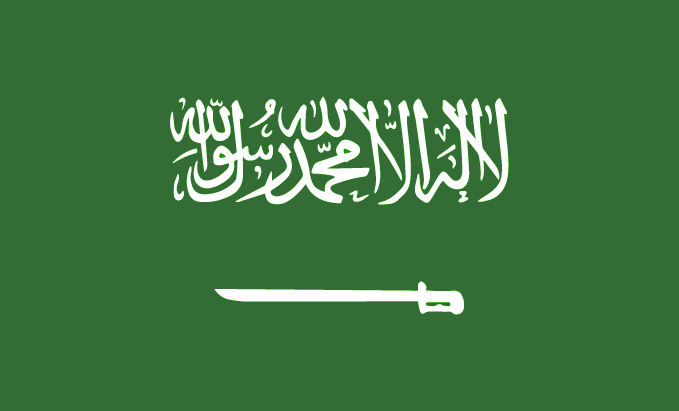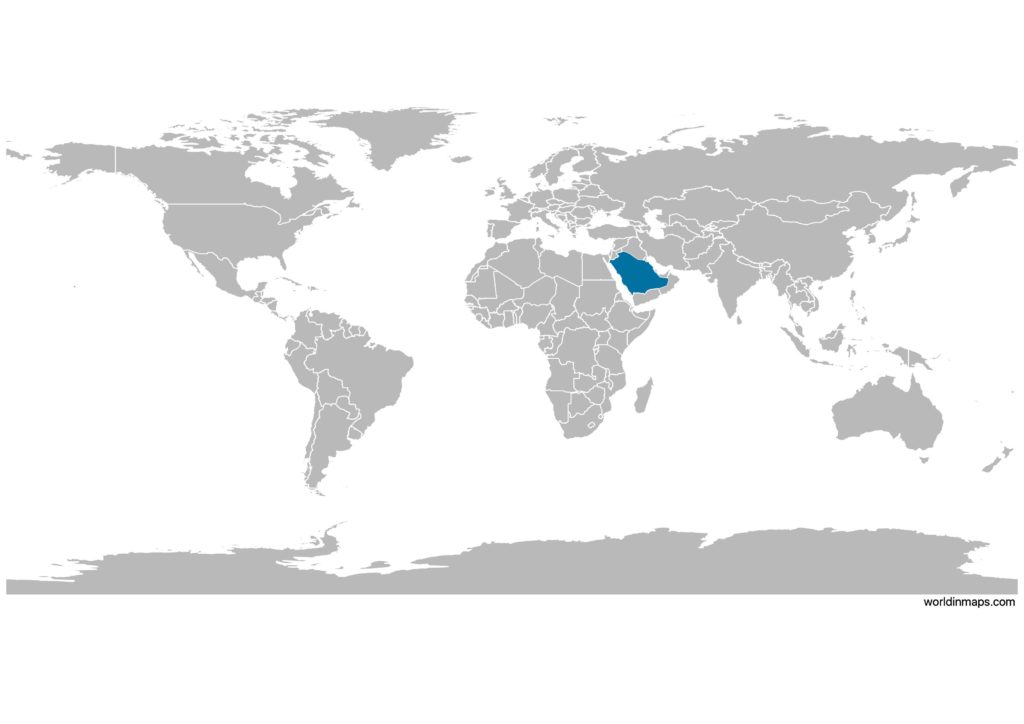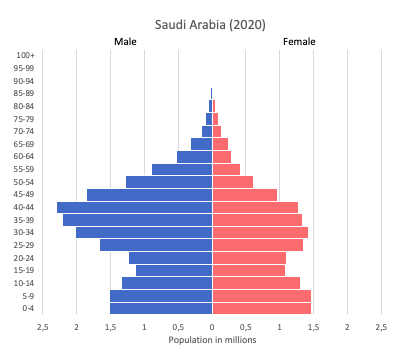Saudi Arabia

| Government | |
| Name | Kingdom of Saudi Arabia |
| Arabic | ٱلْمَمْلَكَة ٱلْعَرَبِيَّة ٱلسَّعُوْدِيَّة Al-Mamlakah al-ʿArabīyah as-Saʿūdīyah |
| Government type | absolute monarchy |
| Capital | Riyadh (7,676,654 (2018)) |
| Currency | Saudi riyal (SAR) |
| People | |
| Population (2020) | 34,813,867 (40th) |
| Density of population | 15 P/km2 (174th) |
| Nationality | Saudi or Saudi Arabian |
| Official languages | |
| Arabic | |
| Ethnic groups | |
| Arab | 90% |
| Afro-Asian | 10% |
| Religions (2012) | |
| Muslim (official; citizens are 85-90% Sunni and 10-15% Shia) | |
| other (includes Eastern Orthodox, Protestant, Roman Catholic, Jewish, Hindu, Buddhist, and Sikh) | |
| note: despite a large expatriate community of various faiths (> 30% of the population), most forms of public religious expression inconsistent with the government-sanctioned interpretation of Sunni Islam are restricted. Non-Muslims are not allowed to have Saudi citizenship and non-Muslim places of worship are not permitted . | |
| Life expectancy (2020) | |
| Male | 74.6 years |
| Female | 77.8 years |
| Total population | 76.2 years (102nd) |
| Homicides | |
| Total (2017) | 1.3 per 100,000 people (126th) |
| Geography | |
| Land area | 2,149,690 km2 |
| water area | 0 km2 |
| total area | 2,149,690 km2 (14th) |
| Mean elevation | 665 m |
| Lowest point | |
| Persian Gulf | 0 m |
| Highest point | |
| Jabal Sawda | 3,133 m |
| Land use (2011) | |
| Agricultural land | 80.7% |
| Arable land | 1.5% |
| Permanent crops | 0.1% |
| Permanent pasture | 79.1% |
| Forest | 0.5% |
| Other | 18.8% |
| Urbanization | |
| Urban population (2020) | 84.3% |
| Rate of urbanization | 2.17% annual rate of change (2015 – 2020) |
| Economy | |
| Labor force (2017) | 13.8 million (42nd) – 3.1 million Saudis and 10.7 million non-Saudis |
| Labor force by occupation (2005) | |
| Agriculture | 6.7% |
| Industry | 21.4% |
| Services | 71.9% |
| Unemployment rate (2017) | 6% (92nd) |
| GDP (PPP) (estimate 2019) | |
| Total | $1.924 trillion (14th) |
| Per capita | $56,817(12th) |
| GDP (nominal) (estimate 2019) | |
| Total | $779.289 billion (18th) |
| Per capita | $23,566 (35th) |
| GDP by sector (estimate 2017) | |
| Agriculture | 2.6% |
| Industry | 44.2% |
| Services | 53.2% |
| Exports (2017) | $221.1 billion (24th) |
| Exports partners (2017) | |
| Japan | 12.2% |
| China | 11.7% |
| South Korea | 9% |
| India | 8.9% |
| US | 8.3% |
| UAE | 6.7% |
| Singapore | 4.2% |
| Imports (2017) | $119.3 billion (33rd) |
| Imports partners (2017) | |
| China | 15.4% |
| US | 13.6% |
| UAE | 6.5% |
| Germany | 5.8% |
| Japan | 4.1% |
| India | 4.1% |
| South Korea | 4% |
Saudi Arabia on the world map

Saudi Arabia is located in Asia and more specifically in the Middle East.
Saudi Arabia top 10 largest cities
- Riyadh (7,676,654 – 2018)
- Jeddah (3,976,000 – 2014)
- Mecca (1,919,900 – 2014)
- Medina (1,271,800 – 2013)
- Hofuf (1,136,900 – 2013)
- Ta’if (1,109,800 – 2014)
- Dammam (975,800 – 2013)
- Buraidah (658,600 – 2013)
- Khobar (626,200 – 2013)
- Tabuk (609,000 – 2013)
Demography
Population pyramid

Age structure data
Estimate for 2020:
- 0-14 years: 24.84% (male 4,327,830/female 4,159,242)
- 15-24 years: 15.38% (male 2,741,371/female 2,515,188)
- 25-54 years: 50.2% (male 10,350,028/female 6,804,479)
- 55-64 years: 5.95% (male 1,254,921/female 778,467)
- 65 years and over: 3.63% (male 657,395/female 584,577)
Remark: the age structure of a population affects a nation’s key socioeconomic issues. Countries with young populations (high percentage under age 15) need to invest more in schools, while countries with older populations (high percentage ages 65 and over) need to invest more in the health sector. The age structure can also be used to help predict potential political issues. For example, the rapid growth of a young adult population unable to find employment can lead to unrest.
Population from 1950 to 2020
Source: United Nations, Department of Economic and Social Affairs, Population Division (2019). World Population Prospects 2019, Online Edition. Rev. 1.
Evolution of the life expectancy from 1960 to 2018
Source: World Development Indicators, The World Bank
Economy
Agriculture:
wheat, barley, tomatoes, melons, dates, citrus, mutton, chickens, eggs, milk
Industries:
crude oil production, petroleum refining, basic petrochemicals, ammonia, industrial gases, sodium hydroxide (caustic soda), cement, fertilizer, plastics, metals, commercial ship repair, commercial aircraft repair, construction
Exports – commodities:
petroleum and petroleum products 90% (2012)
Imports – commodities:
machinery and equipment, foodstuffs, chemicals, motor vehicles, textiles
Time zone and current time in Saudi Arabia
Go to our interactive map to get the current time in Saudi Arabia